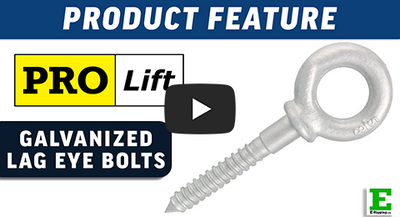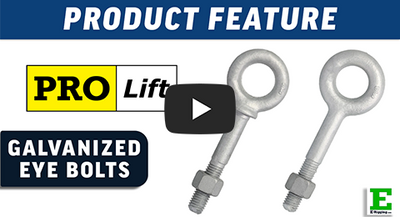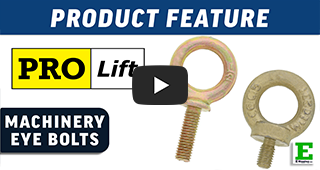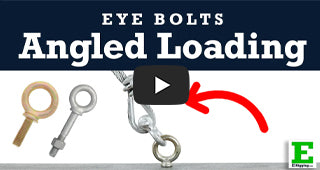At E-Rigging, we offer a comprehensive selection of stainless steel eye bolts, including 316 and 304 stainless steel options, designed for lifting, securing, and rigging in demanding environments. Our full eye bolt inventory features regular, shoulder, machinery, and screw eye bolts, all engineered for strength and reliability in marine, construction, and industrial applications where corrosion resistance is essential. We proudly feature products from Sinox and HAAS Stainless, two trusted names in stainless steel manufacturing. Sinox, new to the U.S. market, produces high-quality stainless steel products in Thailand at an ISO 9001-certified investment casting facility with over 50 years of experience. These products, supplied by United Stainless, meet the rigorous standards demanded by OEMs worldwide. HAAS Stainless, a brand of Sea-Land Distributors, offers precision-engineered stainless steel chain, architectural cable, and cable rail fitting systems manufactured using advanced Swiss-type lathes. Known for superior surface finishes and consistent tolerances, HAAS products provide exceptional corrosion resistance and durability, with their Grand Strand architectural cable recognized as the cleanest and brightest on the market. E-Rigging is your trusted source for durable stainless steel hardware backed by industry-leading brands and designed to excel in the most challenging environments.
Related Categories
FAQs - Stainless Steel Eye Bolts
316 stainless steel eyebolts are highly resistant to corrosion from saltwater, making them a reliable choice for rigging, anchoring, and towing tasks in marine environments.
Yes, 316 stainless steel eyebolts are specifically designed to resist rust and corrosion caused by prolonged exposure to saltwater and other harsh marine conditions.
Regular cleaning with fresh water is essential to remove salt deposits and prevent buildup. Inspections should be conducted to check for any signs of wear or damage.
316 stainless steel contains molybdenum, which provides superior resistance to saltwater corrosion compared to 304 stainless steel, making it the preferred choice for marine applications.
Yes, stainless steel eyebolts, particularly those made of 316 stainless steel, are widely used in mooring systems due to their strength and corrosion resistance in marine settings.
The four main types of eye bolts are regular eye bolts, shoulder eye bolts, screw eye bolts, and machinery eye bolts. At E-Rigging, all these heavy-duty eye bolts are manufactured using the drop-forged process to ensure greater strength and durability.
- Regular and Shoulder Eye Bolts: These two types are nearly identical, except for the shoulder feature on shoulder eye bolts, which provides added stability at the base. This makes shoulder eye bolts the preferred option for applications involving angular loads, while regular eye bolts are only recommended for vertical loads. Both types feature UNC threads for compatibility.
- Screw Eye Bolts: AKA Lag eye bolts, These are designed for screwing directly into wood, these eyebolts do not have a working load limit due to the varying densities and conditions of wood. They are ideal for lighter-duty tasks and securing points in wooden structures.
- Machinery Eye Bolts: Specifically designed with a shoulder for angular loads, machinery eye bolts differ from regular and shoulder eye bolts in that their shank and threads do not protrude through the base material. This design means all the holding strength relies on the threads within the tapped hole, providing a secure hold for machinery and other heavy-duty applications.
The WLL of an eyebolt depends on its size, material, and type. Always refer to the manufacturer’s specifications and ensure the WLL is not exceeded during use to maintain safety. At E-Rigging, we will always list the working load limit on the product page.
Only shoulder eyebolts and machinery eyebolts are designed for angular loads. Regular eyebolts should not be used in situations where the load is applied at an angle, as this can cause bending or failure. For more information on angular loading see our video guide on eye bolt angled loading.
- Never run a sling through multiple eyebolts, as this reduces the effective lift angle and increases strain on the rigging.
- Avoid forcing slings through eyebolts, as this can alter the load or loading angle.
- Do not modify eyebolts by grinding, machining, or stamping them.
- Do not tighten eyebolts using bars, grips, or wrenches. Hand-tighten only.
- Avoid painting eyebolts, as paint can conceal flaws or cracks.
- Do not shock load eyebolts. Gradually apply the load to prevent sudden stress.
- Never insert the point of a hook directly into an eyebolt. Instead, use a properly sized shackle.
- Do not use eyebolts with worn threads, cracks, or other visible damage.
- Avoid using a single eyebolt for lifting loads that are free to rotate.

- Orient the eyebolt in line with the slings to avoid bending under a sideways load.
- Use a spreader bar with regular eye bolts to maintain a 90° lift angle.
- Keep horizontal lift angles above 45°. Remember, sling capacity decreases to 71% at a 45° angle, and eyebolt strength drops to 30% at this angle.
- For angled lifts, use a swivel hoist ring. Swivel hoist rings can rotate and pivot to accommodate any sling angle.
- Attach only one sling leg to each eyebolt.

- Inspect and clean the eyebolt threads and the hole to remove dirt or debris.
- Screw the eyebolt all the way in until it is properly seated.
- For screw eye bolts (body bolts), ensure the tapped hole has a minimum depth of 1.5 times the bolt diameter.
- When installing a shoulder eyebolt, position the shoulder at a right angle to the hole axis, ensuring full contact with the surface of the object being lifted.
- Use washers or shims as needed, but ensure at least 90% of the threads are engaged.
Regular or plain eye bolts are designed for vertical loading only. They should never be used for angle loading, as this can cause the bolt to bend or break. For angled loads, use shoulder eye bolts or a swivel hoist ring.
Swivel hoist rings are specifically designed for angled loads. They rotate around the bolt and pivot 180°, allowing the load to align properly with the sling angle. This reduces stress on the lifting hardware and ensures safer lifting conditions.
Eye bolts are marked with their thread size, not their rated capacities. Always choose an eyebolt based on its type and rated capacity as specified by the manufacturer. Selecting the wrong eyebolt for your lift can lead to equipment failure and safety hazards.






